Business Model Analysis: Wide Open Agriculture (MGMT20143)
VerifiedAdded on 2023/04/20
|16
|2529
|326
Report
AI Summary
This report provides a comprehensive analysis of the business model of Wide Open Agriculture (WOA), an innovative agriculture company. The report utilizes the Business Model Canvas framework, examining its nine key building blocks: customer segments, key partners, value proposition, key activities, key channels, revenue streams, cost structure, key resources, and customer relationships. It delves into the interrelationships between these elements, highlighting critical success factors such as technological advancements, farmer relationships, and financial strategies, while also addressing potential downside risks like population decline and market access. The report concludes with recommendations for WOA, emphasizing the adoption of lean management and the importance of leveraging technology and partnerships for long-term growth and sustainability within the regenerative agriculture sector. The report also incorporates the company's background, its mission to provide high-quality healthy food products and its subsidiary companies to provide an in-depth understanding of WOA's business model.

Business Model 1
Think Big
Think Big
Paraphrase This Document
Need a fresh take? Get an instant paraphrase of this document with our AI Paraphraser
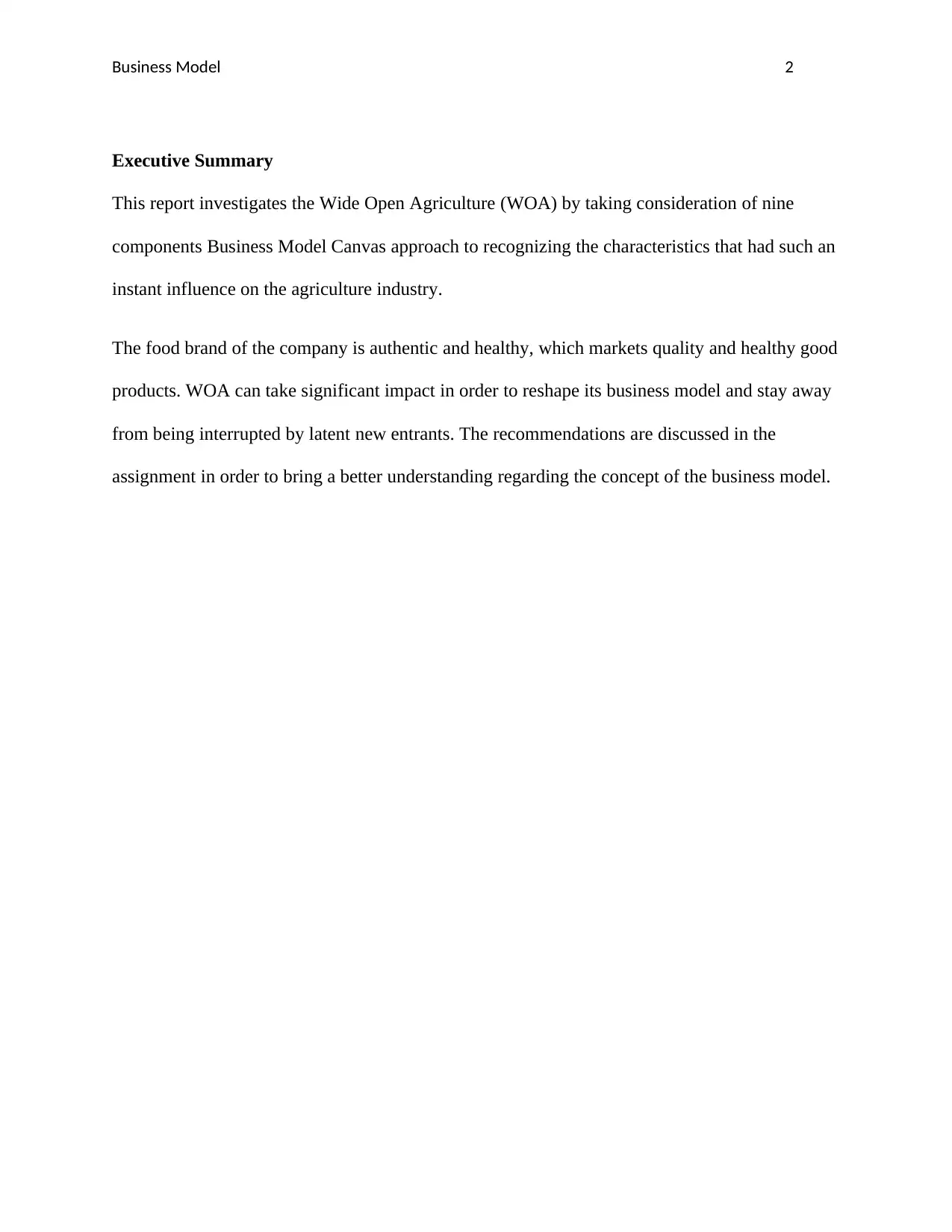
Business Model 2
Executive Summary
This report investigates the Wide Open Agriculture (WOA) by taking consideration of nine
components Business Model Canvas approach to recognizing the characteristics that had such an
instant influence on the agriculture industry.
The food brand of the company is authentic and healthy, which markets quality and healthy good
products. WOA can take significant impact in order to reshape its business model and stay away
from being interrupted by latent new entrants. The recommendations are discussed in the
assignment in order to bring a better understanding regarding the concept of the business model.
Executive Summary
This report investigates the Wide Open Agriculture (WOA) by taking consideration of nine
components Business Model Canvas approach to recognizing the characteristics that had such an
instant influence on the agriculture industry.
The food brand of the company is authentic and healthy, which markets quality and healthy good
products. WOA can take significant impact in order to reshape its business model and stay away
from being interrupted by latent new entrants. The recommendations are discussed in the
assignment in order to bring a better understanding regarding the concept of the business model.
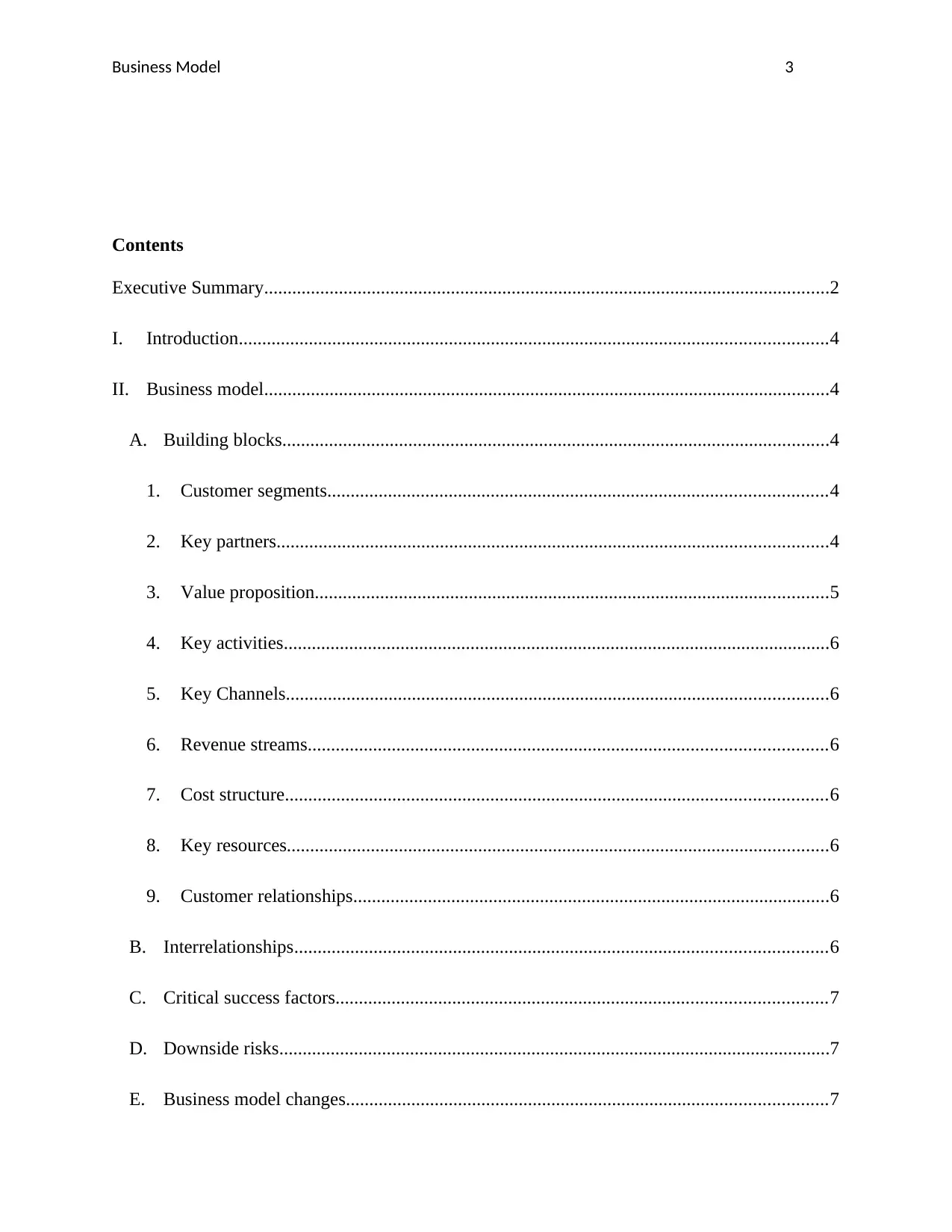
Business Model 3
Contents
Executive Summary.........................................................................................................................2
I. Introduction..............................................................................................................................4
II. Business model.........................................................................................................................4
A. Building blocks.....................................................................................................................4
1. Customer segments...........................................................................................................4
2. Key partners......................................................................................................................4
3. Value proposition..............................................................................................................5
4. Key activities.....................................................................................................................6
5. Key Channels....................................................................................................................6
6. Revenue streams...............................................................................................................6
7. Cost structure....................................................................................................................6
8. Key resources....................................................................................................................6
9. Customer relationships......................................................................................................6
B. Interrelationships..................................................................................................................6
C. Critical success factors.........................................................................................................7
D. Downside risks......................................................................................................................7
E. Business model changes.......................................................................................................7
Contents
Executive Summary.........................................................................................................................2
I. Introduction..............................................................................................................................4
II. Business model.........................................................................................................................4
A. Building blocks.....................................................................................................................4
1. Customer segments...........................................................................................................4
2. Key partners......................................................................................................................4
3. Value proposition..............................................................................................................5
4. Key activities.....................................................................................................................6
5. Key Channels....................................................................................................................6
6. Revenue streams...............................................................................................................6
7. Cost structure....................................................................................................................6
8. Key resources....................................................................................................................6
9. Customer relationships......................................................................................................6
B. Interrelationships..................................................................................................................6
C. Critical success factors.........................................................................................................7
D. Downside risks......................................................................................................................7
E. Business model changes.......................................................................................................7
⊘ This is a preview!⊘
Do you want full access?
Subscribe today to unlock all pages.

Trusted by 1+ million students worldwide

Business Model 4
III. Conclusion and Recommendations.......................................................................................8
Appendix..........................................................................................................................................9
III. Conclusion and Recommendations.......................................................................................8
Appendix..........................................................................................................................................9
Paraphrase This Document
Need a fresh take? Get an instant paraphrase of this document with our AI Paraphraser
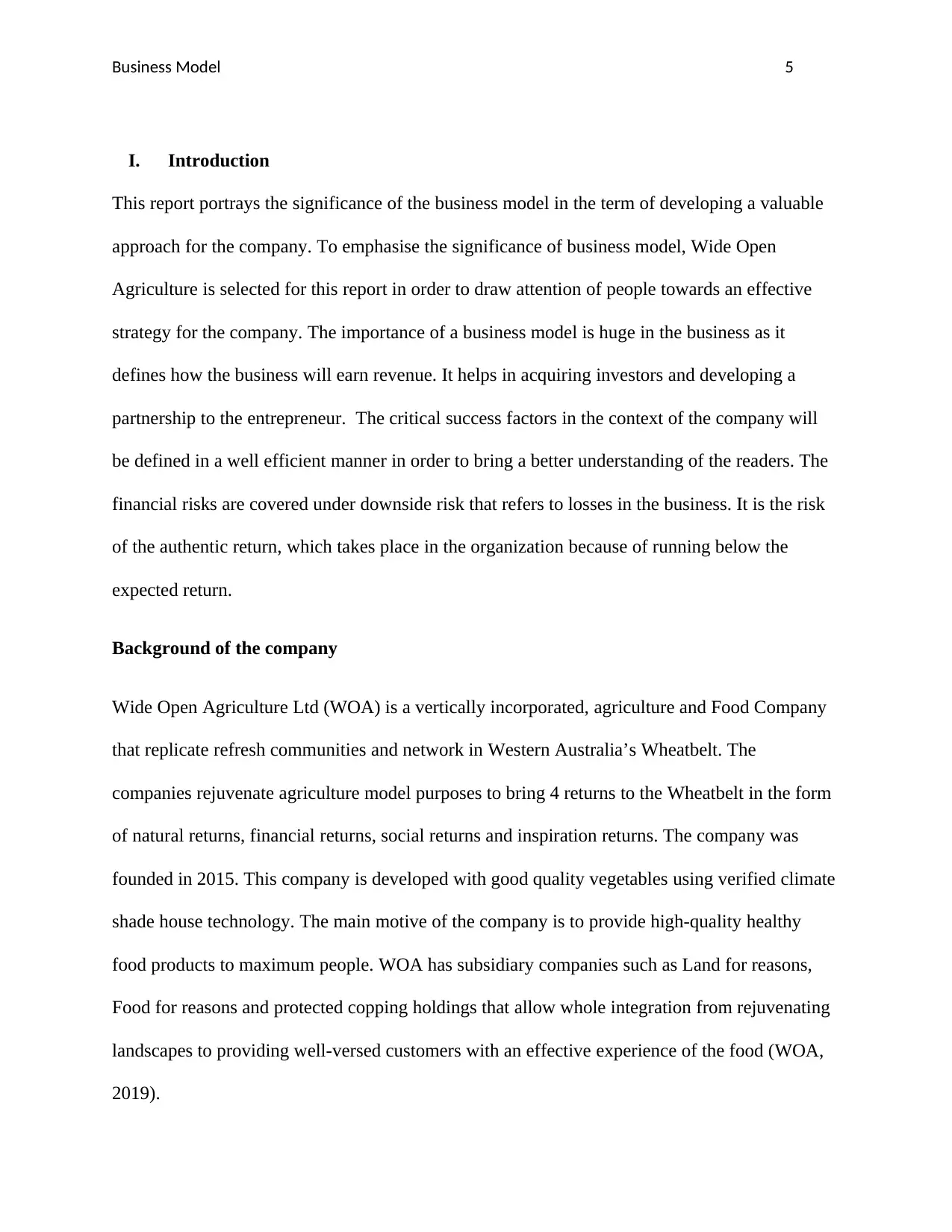
Business Model 5
I. Introduction
This report portrays the significance of the business model in the term of developing a valuable
approach for the company. To emphasise the significance of business model, Wide Open
Agriculture is selected for this report in order to draw attention of people towards an effective
strategy for the company. The importance of a business model is huge in the business as it
defines how the business will earn revenue. It helps in acquiring investors and developing a
partnership to the entrepreneur. The critical success factors in the context of the company will
be defined in a well efficient manner in order to bring a better understanding of the readers. The
financial risks are covered under downside risk that refers to losses in the business. It is the risk
of the authentic return, which takes place in the organization because of running below the
expected return.
Background of the company
Wide Open Agriculture Ltd (WOA) is a vertically incorporated, agriculture and Food Company
that replicate refresh communities and network in Western Australia’s Wheatbelt. The
companies rejuvenate agriculture model purposes to bring 4 returns to the Wheatbelt in the form
of natural returns, financial returns, social returns and inspiration returns. The company was
founded in 2015. This company is developed with good quality vegetables using verified climate
shade house technology. The main motive of the company is to provide high-quality healthy
food products to maximum people. WOA has subsidiary companies such as Land for reasons,
Food for reasons and protected copping holdings that allow whole integration from rejuvenating
landscapes to providing well-versed customers with an effective experience of the food (WOA,
2019).
I. Introduction
This report portrays the significance of the business model in the term of developing a valuable
approach for the company. To emphasise the significance of business model, Wide Open
Agriculture is selected for this report in order to draw attention of people towards an effective
strategy for the company. The importance of a business model is huge in the business as it
defines how the business will earn revenue. It helps in acquiring investors and developing a
partnership to the entrepreneur. The critical success factors in the context of the company will
be defined in a well efficient manner in order to bring a better understanding of the readers. The
financial risks are covered under downside risk that refers to losses in the business. It is the risk
of the authentic return, which takes place in the organization because of running below the
expected return.
Background of the company
Wide Open Agriculture Ltd (WOA) is a vertically incorporated, agriculture and Food Company
that replicate refresh communities and network in Western Australia’s Wheatbelt. The
companies rejuvenate agriculture model purposes to bring 4 returns to the Wheatbelt in the form
of natural returns, financial returns, social returns and inspiration returns. The company was
founded in 2015. This company is developed with good quality vegetables using verified climate
shade house technology. The main motive of the company is to provide high-quality healthy
food products to maximum people. WOA has subsidiary companies such as Land for reasons,
Food for reasons and protected copping holdings that allow whole integration from rejuvenating
landscapes to providing well-versed customers with an effective experience of the food (WOA,
2019).
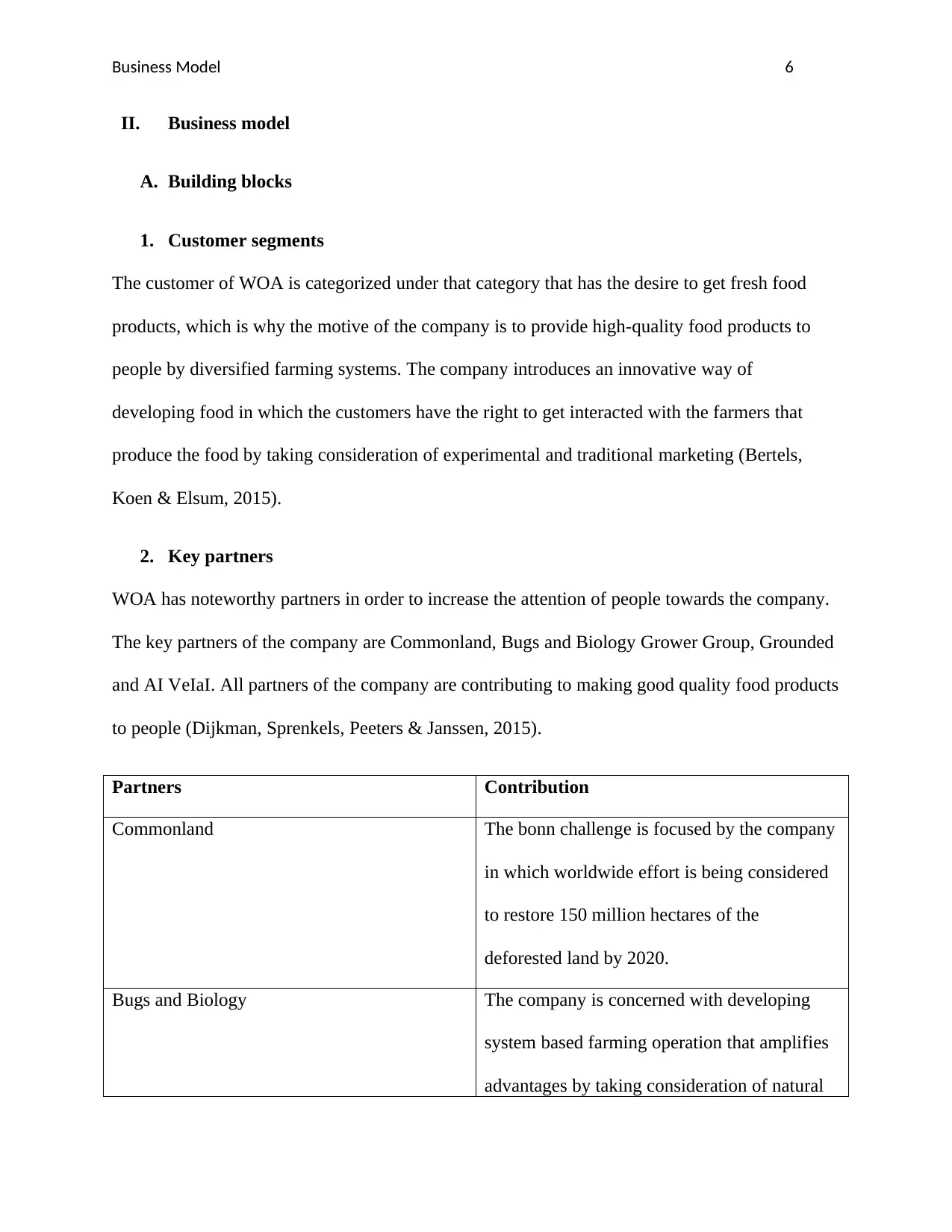
Business Model 6
II. Business model
A. Building blocks
1. Customer segments
The customer of WOA is categorized under that category that has the desire to get fresh food
products, which is why the motive of the company is to provide high-quality food products to
people by diversified farming systems. The company introduces an innovative way of
developing food in which the customers have the right to get interacted with the farmers that
produce the food by taking consideration of experimental and traditional marketing (Bertels,
Koen & Elsum, 2015).
2. Key partners
WOA has noteworthy partners in order to increase the attention of people towards the company.
The key partners of the company are Commonland, Bugs and Biology Grower Group, Grounded
and AI VeIaI. All partners of the company are contributing to making good quality food products
to people (Dijkman, Sprenkels, Peeters & Janssen, 2015).
Partners Contribution
Commonland The bonn challenge is focused by the company
in which worldwide effort is being considered
to restore 150 million hectares of the
deforested land by 2020.
Bugs and Biology The company is concerned with developing
system based farming operation that amplifies
advantages by taking consideration of natural
II. Business model
A. Building blocks
1. Customer segments
The customer of WOA is categorized under that category that has the desire to get fresh food
products, which is why the motive of the company is to provide high-quality food products to
people by diversified farming systems. The company introduces an innovative way of
developing food in which the customers have the right to get interacted with the farmers that
produce the food by taking consideration of experimental and traditional marketing (Bertels,
Koen & Elsum, 2015).
2. Key partners
WOA has noteworthy partners in order to increase the attention of people towards the company.
The key partners of the company are Commonland, Bugs and Biology Grower Group, Grounded
and AI VeIaI. All partners of the company are contributing to making good quality food products
to people (Dijkman, Sprenkels, Peeters & Janssen, 2015).
Partners Contribution
Commonland The bonn challenge is focused by the company
in which worldwide effort is being considered
to restore 150 million hectares of the
deforested land by 2020.
Bugs and Biology The company is concerned with developing
system based farming operation that amplifies
advantages by taking consideration of natural
⊘ This is a preview!⊘
Do you want full access?
Subscribe today to unlock all pages.

Trusted by 1+ million students worldwide
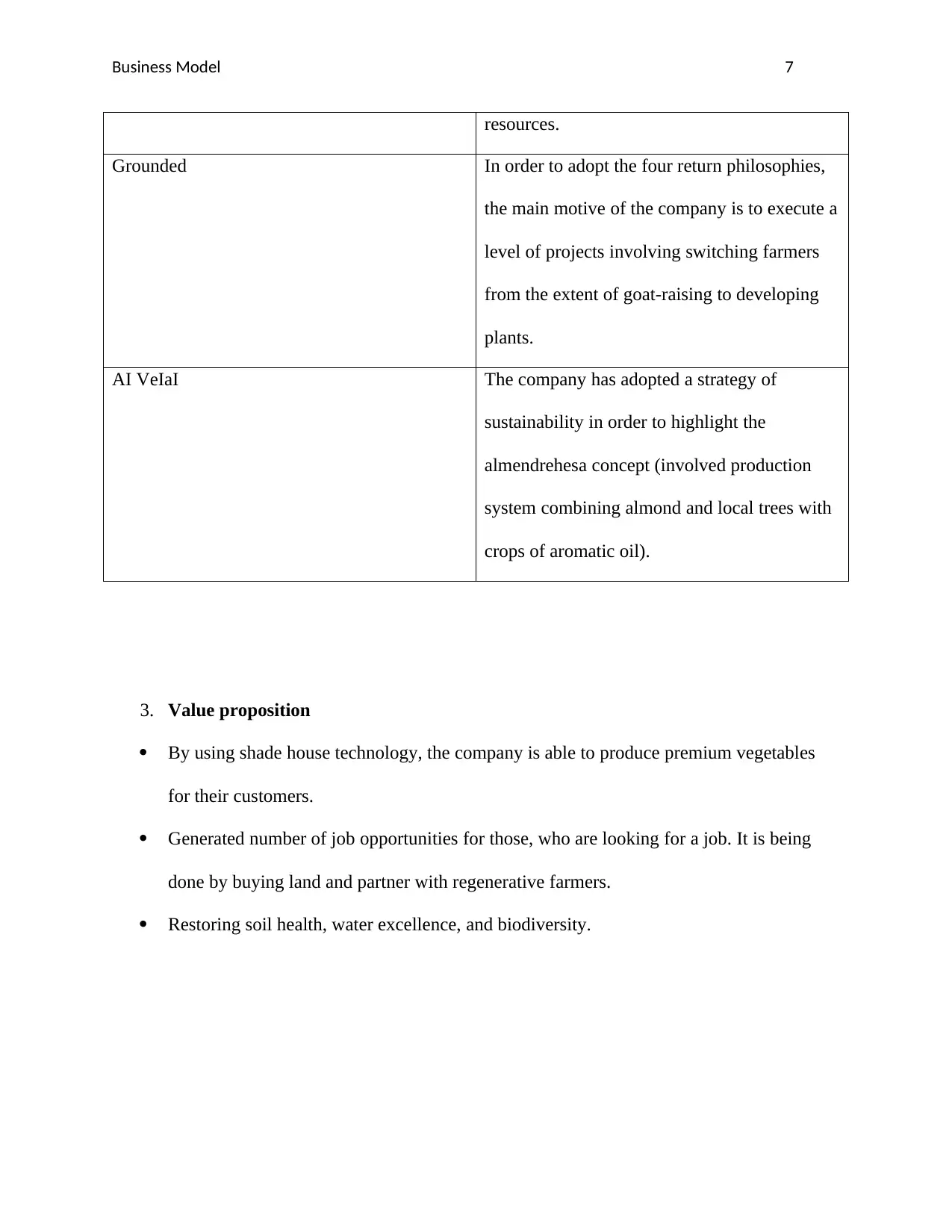
Business Model 7
resources.
Grounded In order to adopt the four return philosophies,
the main motive of the company is to execute a
level of projects involving switching farmers
from the extent of goat-raising to developing
plants.
AI VeIaI The company has adopted a strategy of
sustainability in order to highlight the
almendrehesa concept (involved production
system combining almond and local trees with
crops of aromatic oil).
3. Value proposition
By using shade house technology, the company is able to produce premium vegetables
for their customers.
Generated number of job opportunities for those, who are looking for a job. It is being
done by buying land and partner with regenerative farmers.
Restoring soil health, water excellence, and biodiversity.
resources.
Grounded In order to adopt the four return philosophies,
the main motive of the company is to execute a
level of projects involving switching farmers
from the extent of goat-raising to developing
plants.
AI VeIaI The company has adopted a strategy of
sustainability in order to highlight the
almendrehesa concept (involved production
system combining almond and local trees with
crops of aromatic oil).
3. Value proposition
By using shade house technology, the company is able to produce premium vegetables
for their customers.
Generated number of job opportunities for those, who are looking for a job. It is being
done by buying land and partner with regenerative farmers.
Restoring soil health, water excellence, and biodiversity.
Paraphrase This Document
Need a fresh take? Get an instant paraphrase of this document with our AI Paraphraser
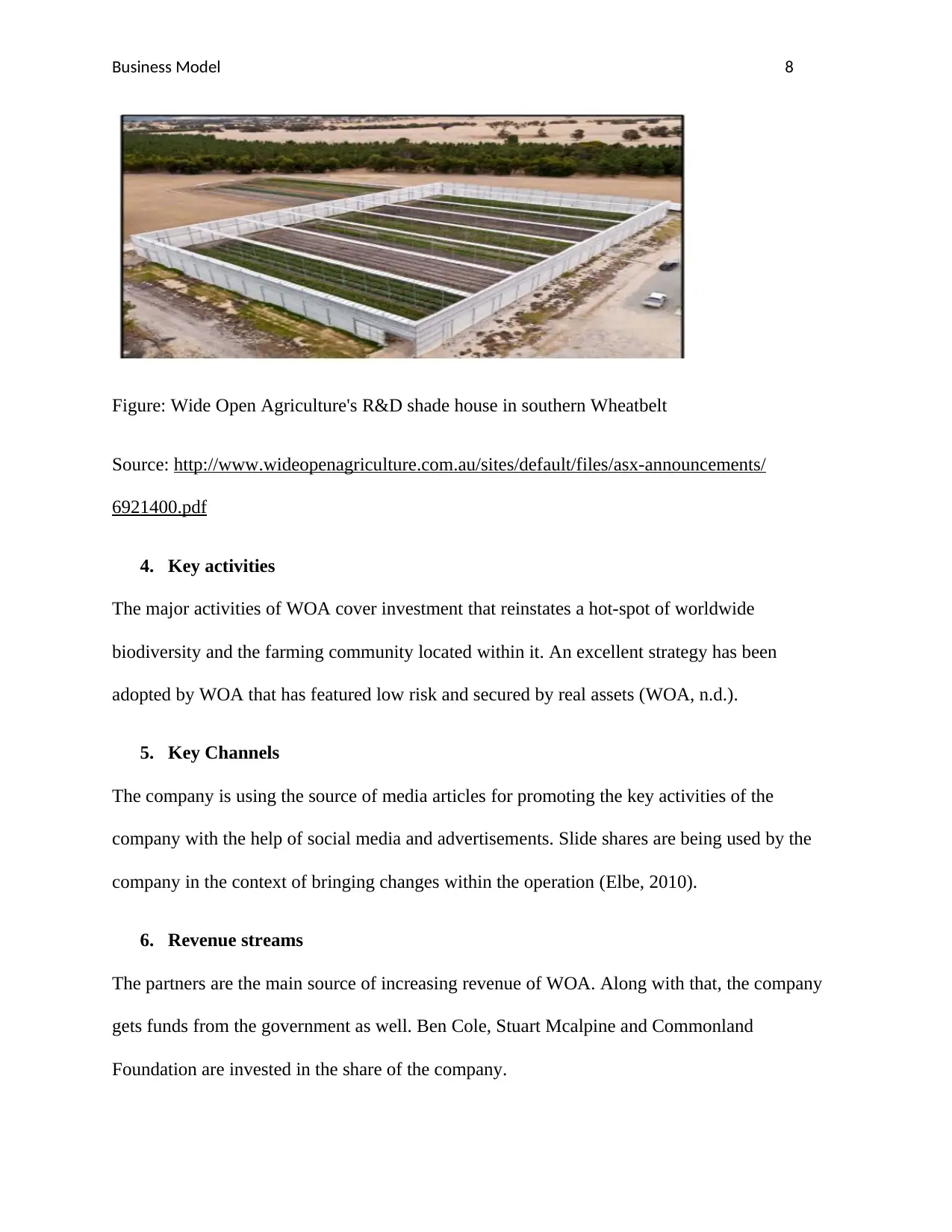
Business Model 8
Figure: Wide Open Agriculture's R&D shade house in southern Wheatbelt
Source: http://www.wideopenagriculture.com.au/sites/default/files/asx-announcements/
6921400.pdf
4. Key activities
The major activities of WOA cover investment that reinstates a hot-spot of worldwide
biodiversity and the farming community located within it. An excellent strategy has been
adopted by WOA that has featured low risk and secured by real assets (WOA, n.d.).
5. Key Channels
The company is using the source of media articles for promoting the key activities of the
company with the help of social media and advertisements. Slide shares are being used by the
company in the context of bringing changes within the operation (Elbe, 2010).
6. Revenue streams
The partners are the main source of increasing revenue of WOA. Along with that, the company
gets funds from the government as well. Ben Cole, Stuart Mcalpine and Commonland
Foundation are invested in the share of the company.
Figure: Wide Open Agriculture's R&D shade house in southern Wheatbelt
Source: http://www.wideopenagriculture.com.au/sites/default/files/asx-announcements/
6921400.pdf
4. Key activities
The major activities of WOA cover investment that reinstates a hot-spot of worldwide
biodiversity and the farming community located within it. An excellent strategy has been
adopted by WOA that has featured low risk and secured by real assets (WOA, n.d.).
5. Key Channels
The company is using the source of media articles for promoting the key activities of the
company with the help of social media and advertisements. Slide shares are being used by the
company in the context of bringing changes within the operation (Elbe, 2010).
6. Revenue streams
The partners are the main source of increasing revenue of WOA. Along with that, the company
gets funds from the government as well. Ben Cole, Stuart Mcalpine and Commonland
Foundation are invested in the share of the company.
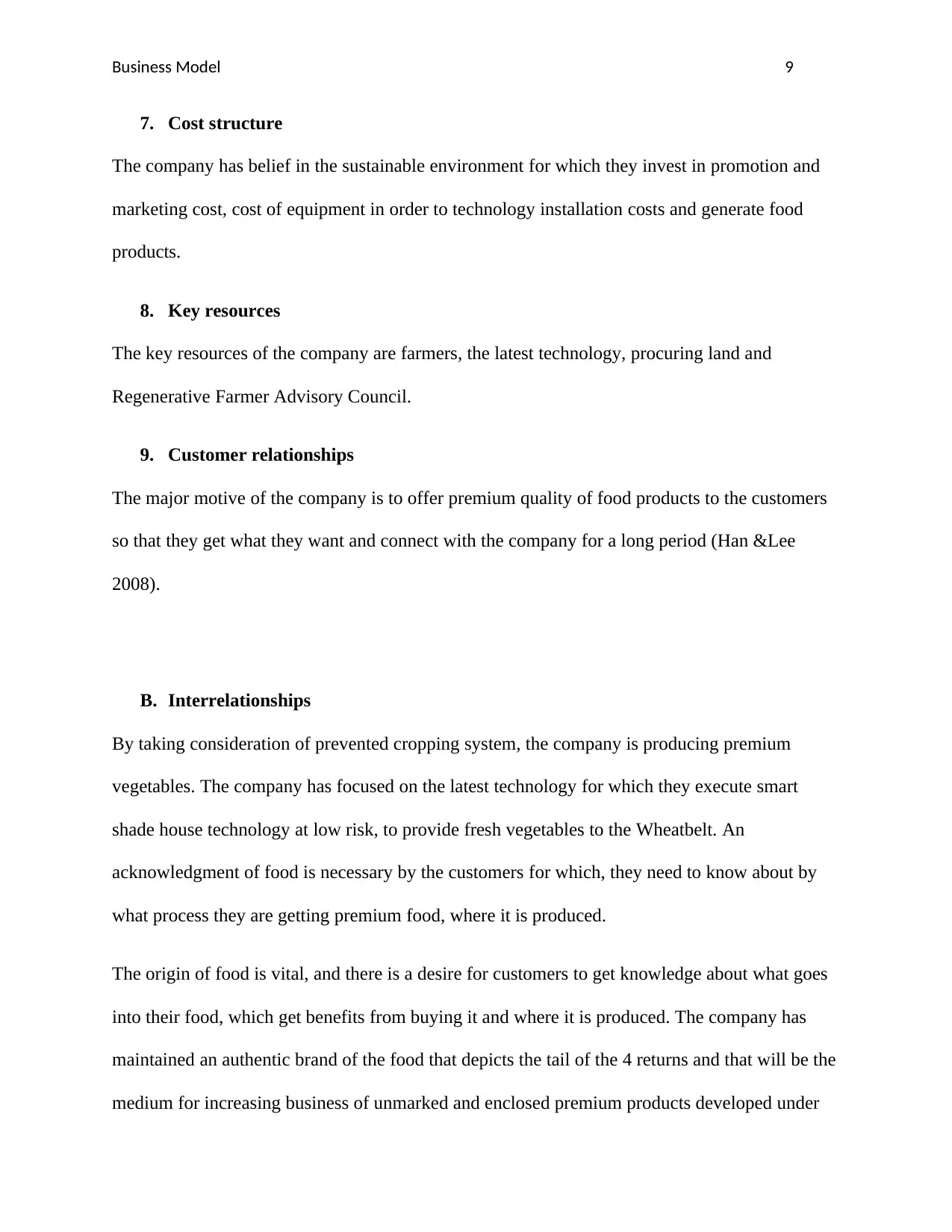
Business Model 9
7. Cost structure
The company has belief in the sustainable environment for which they invest in promotion and
marketing cost, cost of equipment in order to technology installation costs and generate food
products.
8. Key resources
The key resources of the company are farmers, the latest technology, procuring land and
Regenerative Farmer Advisory Council.
9. Customer relationships
The major motive of the company is to offer premium quality of food products to the customers
so that they get what they want and connect with the company for a long period (Han &Lee
2008).
B. Interrelationships
By taking consideration of prevented cropping system, the company is producing premium
vegetables. The company has focused on the latest technology for which they execute smart
shade house technology at low risk, to provide fresh vegetables to the Wheatbelt. An
acknowledgment of food is necessary by the customers for which, they need to know about by
what process they are getting premium food, where it is produced.
The origin of food is vital, and there is a desire for customers to get knowledge about what goes
into their food, which get benefits from buying it and where it is produced. The company has
maintained an authentic brand of the food that depicts the tail of the 4 returns and that will be the
medium for increasing business of unmarked and enclosed premium products developed under
7. Cost structure
The company has belief in the sustainable environment for which they invest in promotion and
marketing cost, cost of equipment in order to technology installation costs and generate food
products.
8. Key resources
The key resources of the company are farmers, the latest technology, procuring land and
Regenerative Farmer Advisory Council.
9. Customer relationships
The major motive of the company is to offer premium quality of food products to the customers
so that they get what they want and connect with the company for a long period (Han &Lee
2008).
B. Interrelationships
By taking consideration of prevented cropping system, the company is producing premium
vegetables. The company has focused on the latest technology for which they execute smart
shade house technology at low risk, to provide fresh vegetables to the Wheatbelt. An
acknowledgment of food is necessary by the customers for which, they need to know about by
what process they are getting premium food, where it is produced.
The origin of food is vital, and there is a desire for customers to get knowledge about what goes
into their food, which get benefits from buying it and where it is produced. The company has
maintained an authentic brand of the food that depicts the tail of the 4 returns and that will be the
medium for increasing business of unmarked and enclosed premium products developed under
⊘ This is a preview!⊘
Do you want full access?
Subscribe today to unlock all pages.

Trusted by 1+ million students worldwide
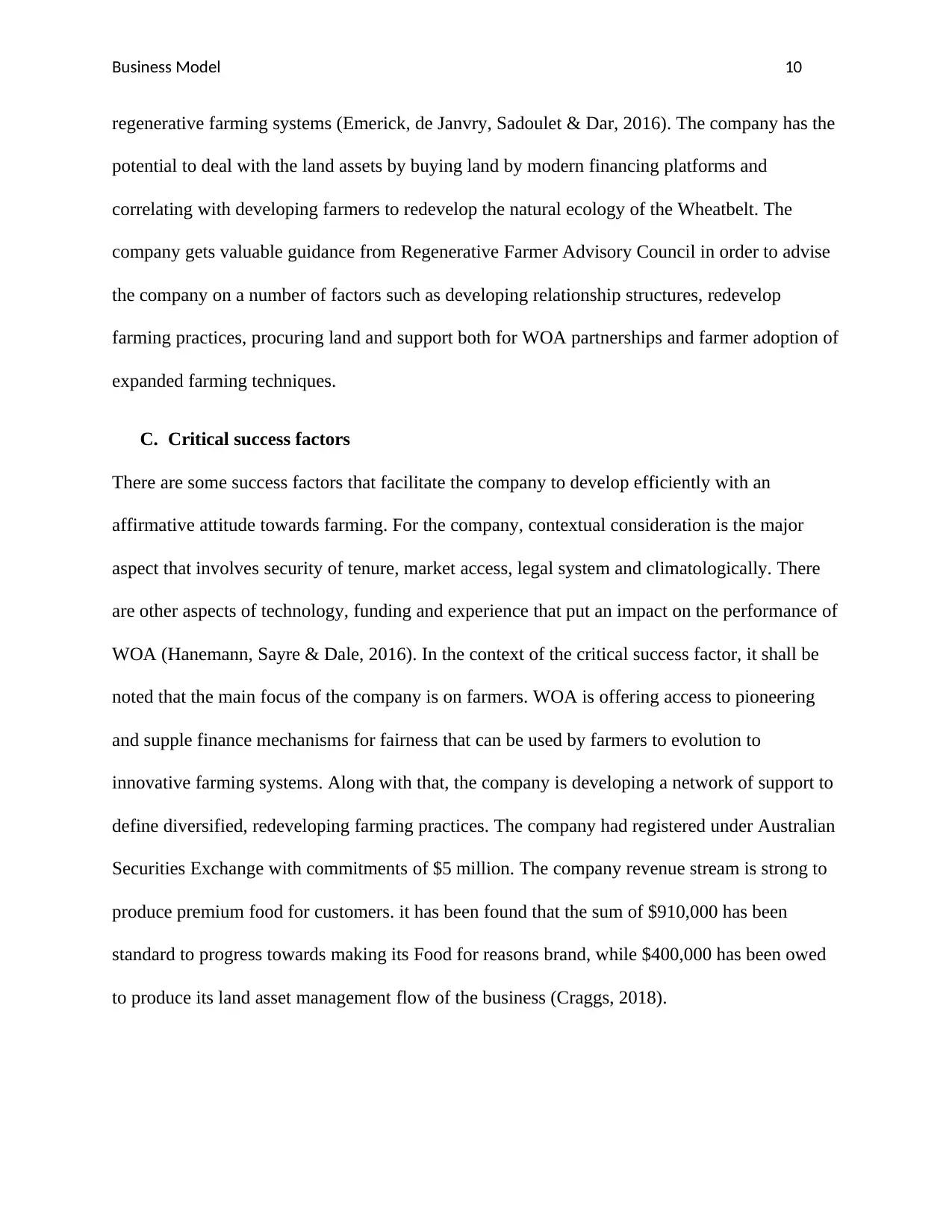
Business Model 10
regenerative farming systems (Emerick, de Janvry, Sadoulet & Dar, 2016). The company has the
potential to deal with the land assets by buying land by modern financing platforms and
correlating with developing farmers to redevelop the natural ecology of the Wheatbelt. The
company gets valuable guidance from Regenerative Farmer Advisory Council in order to advise
the company on a number of factors such as developing relationship structures, redevelop
farming practices, procuring land and support both for WOA partnerships and farmer adoption of
expanded farming techniques.
C. Critical success factors
There are some success factors that facilitate the company to develop efficiently with an
affirmative attitude towards farming. For the company, contextual consideration is the major
aspect that involves security of tenure, market access, legal system and climatologically. There
are other aspects of technology, funding and experience that put an impact on the performance of
WOA (Hanemann, Sayre & Dale, 2016). In the context of the critical success factor, it shall be
noted that the main focus of the company is on farmers. WOA is offering access to pioneering
and supple finance mechanisms for fairness that can be used by farmers to evolution to
innovative farming systems. Along with that, the company is developing a network of support to
define diversified, redeveloping farming practices. The company had registered under Australian
Securities Exchange with commitments of $5 million. The company revenue stream is strong to
produce premium food for customers. it has been found that the sum of $910,000 has been
standard to progress towards making its Food for reasons brand, while $400,000 has been owed
to produce its land asset management flow of the business (Craggs, 2018).
regenerative farming systems (Emerick, de Janvry, Sadoulet & Dar, 2016). The company has the
potential to deal with the land assets by buying land by modern financing platforms and
correlating with developing farmers to redevelop the natural ecology of the Wheatbelt. The
company gets valuable guidance from Regenerative Farmer Advisory Council in order to advise
the company on a number of factors such as developing relationship structures, redevelop
farming practices, procuring land and support both for WOA partnerships and farmer adoption of
expanded farming techniques.
C. Critical success factors
There are some success factors that facilitate the company to develop efficiently with an
affirmative attitude towards farming. For the company, contextual consideration is the major
aspect that involves security of tenure, market access, legal system and climatologically. There
are other aspects of technology, funding and experience that put an impact on the performance of
WOA (Hanemann, Sayre & Dale, 2016). In the context of the critical success factor, it shall be
noted that the main focus of the company is on farmers. WOA is offering access to pioneering
and supple finance mechanisms for fairness that can be used by farmers to evolution to
innovative farming systems. Along with that, the company is developing a network of support to
define diversified, redeveloping farming practices. The company had registered under Australian
Securities Exchange with commitments of $5 million. The company revenue stream is strong to
produce premium food for customers. it has been found that the sum of $910,000 has been
standard to progress towards making its Food for reasons brand, while $400,000 has been owed
to produce its land asset management flow of the business (Craggs, 2018).
Paraphrase This Document
Need a fresh take? Get an instant paraphrase of this document with our AI Paraphraser
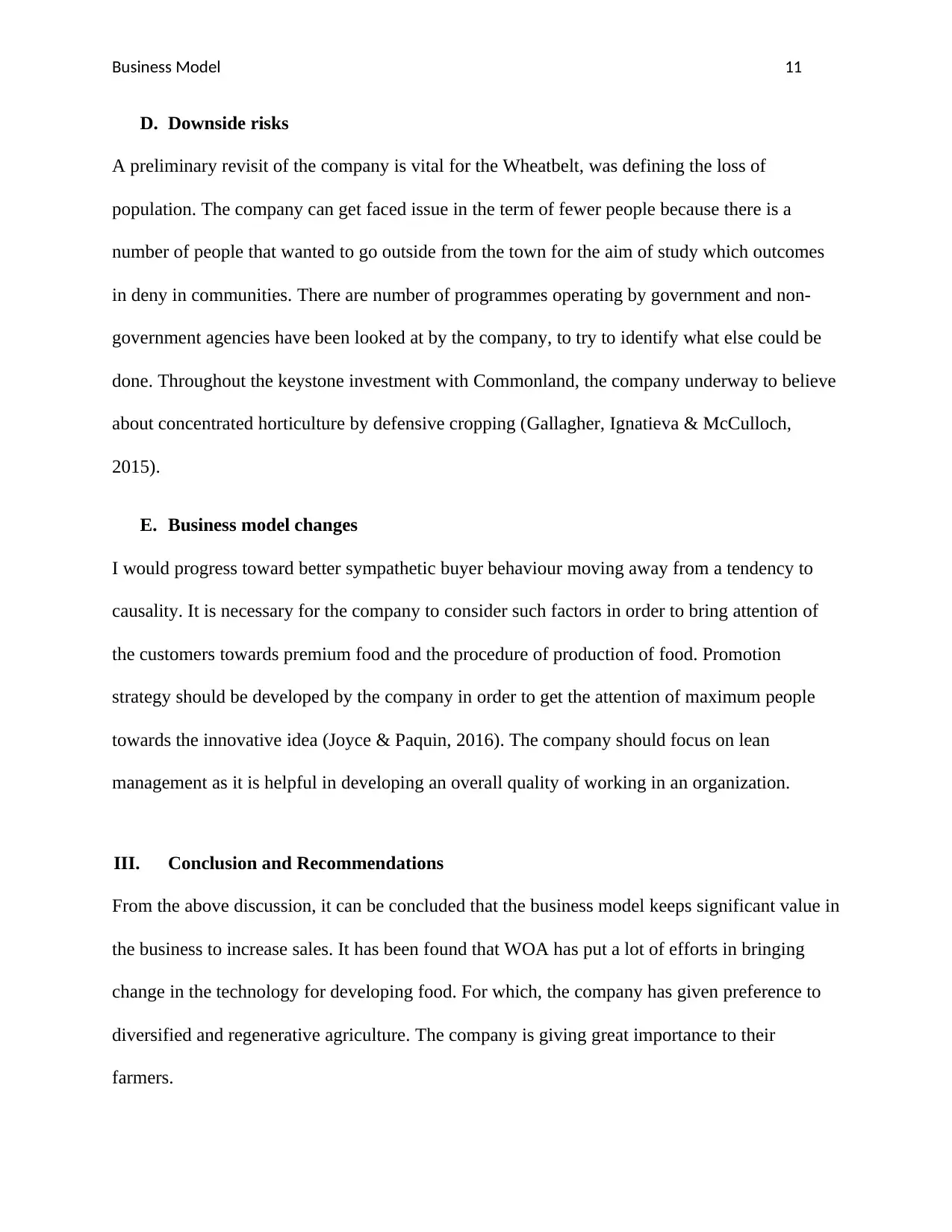
Business Model 11
D. Downside risks
A preliminary revisit of the company is vital for the Wheatbelt, was defining the loss of
population. The company can get faced issue in the term of fewer people because there is a
number of people that wanted to go outside from the town for the aim of study which outcomes
in deny in communities. There are number of programmes operating by government and non-
government agencies have been looked at by the company, to try to identify what else could be
done. Throughout the keystone investment with Commonland, the company underway to believe
about concentrated horticulture by defensive cropping (Gallagher, Ignatieva & McCulloch,
2015).
E. Business model changes
I would progress toward better sympathetic buyer behaviour moving away from a tendency to
causality. It is necessary for the company to consider such factors in order to bring attention of
the customers towards premium food and the procedure of production of food. Promotion
strategy should be developed by the company in order to get the attention of maximum people
towards the innovative idea (Joyce & Paquin, 2016). The company should focus on lean
management as it is helpful in developing an overall quality of working in an organization.
III. Conclusion and Recommendations
From the above discussion, it can be concluded that the business model keeps significant value in
the business to increase sales. It has been found that WOA has put a lot of efforts in bringing
change in the technology for developing food. For which, the company has given preference to
diversified and regenerative agriculture. The company is giving great importance to their
farmers.
D. Downside risks
A preliminary revisit of the company is vital for the Wheatbelt, was defining the loss of
population. The company can get faced issue in the term of fewer people because there is a
number of people that wanted to go outside from the town for the aim of study which outcomes
in deny in communities. There are number of programmes operating by government and non-
government agencies have been looked at by the company, to try to identify what else could be
done. Throughout the keystone investment with Commonland, the company underway to believe
about concentrated horticulture by defensive cropping (Gallagher, Ignatieva & McCulloch,
2015).
E. Business model changes
I would progress toward better sympathetic buyer behaviour moving away from a tendency to
causality. It is necessary for the company to consider such factors in order to bring attention of
the customers towards premium food and the procedure of production of food. Promotion
strategy should be developed by the company in order to get the attention of maximum people
towards the innovative idea (Joyce & Paquin, 2016). The company should focus on lean
management as it is helpful in developing an overall quality of working in an organization.
III. Conclusion and Recommendations
From the above discussion, it can be concluded that the business model keeps significant value in
the business to increase sales. It has been found that WOA has put a lot of efforts in bringing
change in the technology for developing food. For which, the company has given preference to
diversified and regenerative agriculture. The company is giving great importance to their
farmers.
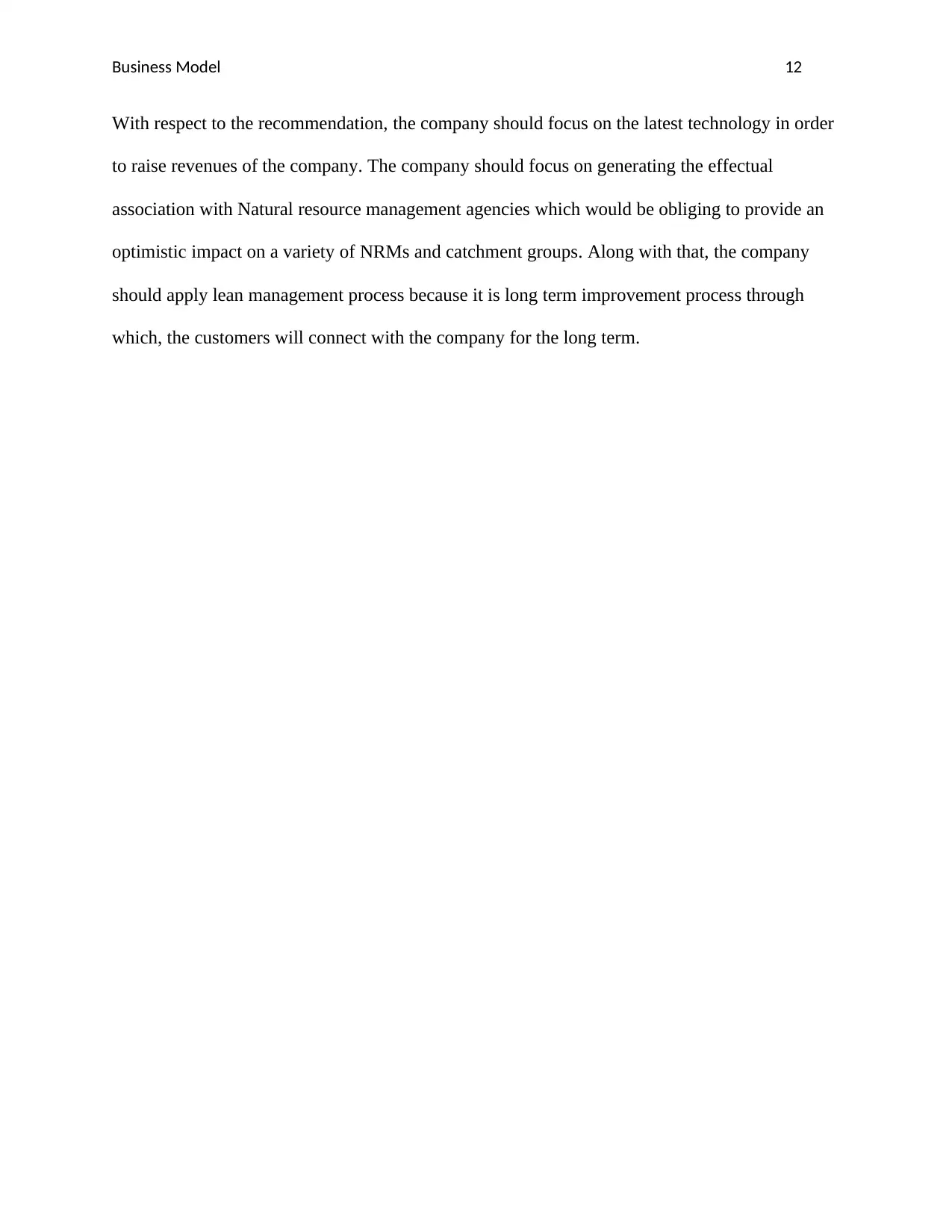
Business Model 12
With respect to the recommendation, the company should focus on the latest technology in order
to raise revenues of the company. The company should focus on generating the effectual
association with Natural resource management agencies which would be obliging to provide an
optimistic impact on a variety of NRMs and catchment groups. Along with that, the company
should apply lean management process because it is long term improvement process through
which, the customers will connect with the company for the long term.
With respect to the recommendation, the company should focus on the latest technology in order
to raise revenues of the company. The company should focus on generating the effectual
association with Natural resource management agencies which would be obliging to provide an
optimistic impact on a variety of NRMs and catchment groups. Along with that, the company
should apply lean management process because it is long term improvement process through
which, the customers will connect with the company for the long term.
⊘ This is a preview!⊘
Do you want full access?
Subscribe today to unlock all pages.

Trusted by 1+ million students worldwide
1 out of 16
Related Documents
Your All-in-One AI-Powered Toolkit for Academic Success.
+13062052269
info@desklib.com
Available 24*7 on WhatsApp / Email
![[object Object]](/_next/static/media/star-bottom.7253800d.svg)
Unlock your academic potential
Copyright © 2020–2025 A2Z Services. All Rights Reserved. Developed and managed by ZUCOL.





